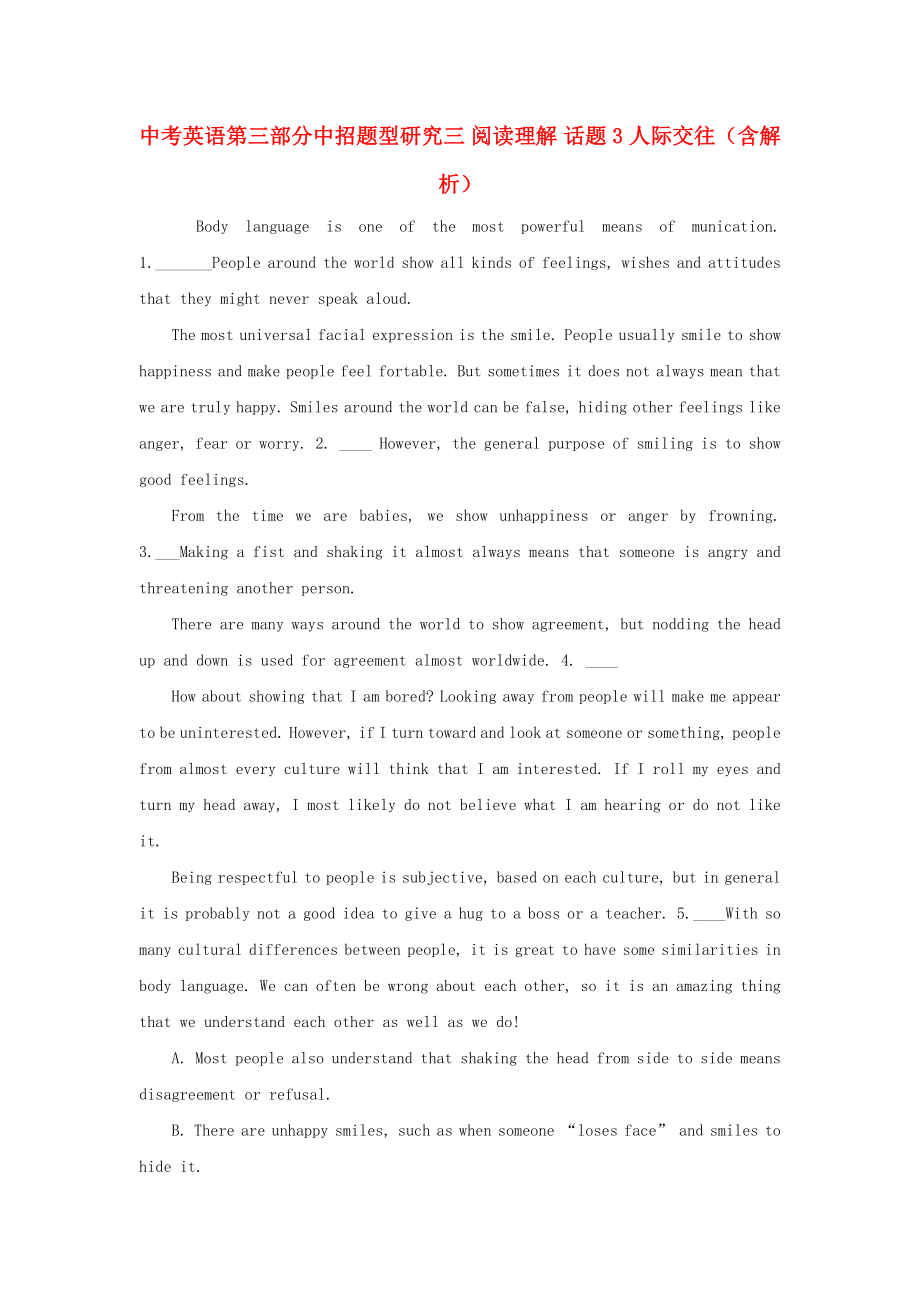《中考英語(yǔ)第三部分中招題型研究三 閱讀理解 話題3 人際交往(含解析)》由會(huì)員分享�,可在線閱讀,更多相關(guān)《中考英語(yǔ)第三部分中招題型研究三 閱讀理解 話題3 人際交往(含解析)(3頁(yè)珍藏版)》請(qǐng)?jiān)谘b配圖網(wǎng)上搜索。
1����、中考英語(yǔ)第三部分中招題型研究三 閱讀理解 話題3 人際交往(含解析)
Body language is one of the most powerful means of munication. 1._______People around the world show all kinds of feelings, wishes and attitudes that they might never speak aloud.
The most universal facial expression is the smile. People usually smile to show
2��、happiness and make people feel fortable. But sometimes it does not always mean that we are truly happy. Smiles around the world can be false, hiding other feelings like anger, fear or worry. 2. ____ However, the general purpose of smiling is to show good feelings.
From the time we are babies, we s
3���、how unhappiness or anger by frowning. 3.___Making a fist and shaking it almost always means that someone is angry and threatening another person.
There are many ways around the world to show agreement, but nodding the head up and down is used for agreement almost worldwide. 4. ____
How about sho
4���、wing that I am bored? Looking away from people will make me appear to be uninterested. However, if I turn toward and look at someone or something, people from almost every culture will think that I am interested. If I roll my eyes and turn my head away, I most likely do not believe what I am hearing
5��、 or do not like it.
Being respectful to people is subjective, based on each culture, but in general it is probably not a good idea to give a hug to a boss or a teacher. 5.____With so many cultural differences between people, it is great to have some similarities in body language. We can often be wr
6�����、ong about each other, so it is an amazing thing that we understand each other as well as we do!
A. Most people also understand that shaking the head from side to side means disagreement or refusal.
B. There are unhappy smiles, such as when someone “l(fā)oses face” and smiles to hide it.
C. It is ofte
7���、n even more powerful than spoken language.
D. Standing at a little distance with open hands will show that I am willing to listen.
E. In most places around the world, frowning and turning one’s back to someone shows anger.
【主旨大意】本文是一篇說明文�。介紹了肢體語(yǔ)言是最有力量的交流方式之一��,有時(shí)甚至比語(yǔ)言更有用�����。當(dāng)然�����,由于文化差異����,肢體語(yǔ)言有時(shí)也會(huì)被誤解��。我們可能經(jīng)
8�����、常相互誤解��,但是也應(yīng)該相互理解����。
【備選分析】
A. Most people also understand that shaking the head from side to side means disagreement or refusal.大多數(shù)人也明白搖頭表示不同意或拒絕�。
B. There are unhappy smiles, such as when someone “l(fā)oses face” and smiles to hide it.還有不愉快的微笑�����,比如當(dāng)某人“丟了面子”就會(huì)用微笑來掩飾。
C. It is often even more powerful tha
9�、n spoken language.它甚至經(jīng)常比口頭語(yǔ)言更有力量���。
D. Standing at a little distance with open hands will show that I am willing to listen.保持一定的距離�,把手微微張開�����,表示我愿意傾聽�����。
E. In most places around the world, frowning and turning one’s back to someone shows anger.在世界上大多數(shù)地方�,皺眉或者背對(duì)著某人表示發(fā)怒�����。
1. C【解析】根據(jù)上句“肢體語(yǔ)言是最有力量的交流方式之一��?��!?可知此處
10、是繼續(xù)介紹肢體語(yǔ)言的作用�。結(jié)合備選項(xiàng)C項(xiàng)“它甚至經(jīng)常比口頭語(yǔ)言更有力量����?���!笨芍?,也是介紹肢體語(yǔ)言的作用���,符合語(yǔ)境�。故選C�����。
2. B【解析】根據(jù)上句“世界上的很多微笑可能是假象�,隱藏其他像憤怒����、恐懼和焦慮之類的情感����?!笨芍酉聛硪e個(gè)例子來說明微笑并不總代表快樂�。結(jié)合備選項(xiàng)可知���,B項(xiàng)舉例說明還有不愉快的微笑�����,比如當(dāng)某人“丟了面子”就會(huì)用微笑來掩飾���。故選B。
3. E【解析】根據(jù)上句“從我們還是嬰兒的時(shí)候����,我們通過皺眉來表達(dá)不高興或者生氣。”和下句“握緊或者揮舞拳頭一般意味著某人很生氣并且在威脅別人�。”可知這一整段都是介紹怎樣用肢體語(yǔ)言表達(dá)生氣或不高興�。結(jié)合備選項(xiàng)可知,只有E項(xiàng)“在世界上大多數(shù)地方�����,皺眉或者背對(duì)著某人表示發(fā)怒�����?��!狈险Z(yǔ)境�����。故選E。
4. A【解析】根據(jù)上句“世界上有很多方法是用來表達(dá)同意的,但是幾乎全世界都是用點(diǎn)頭來表示同意���?����!苯Y(jié)合備選項(xiàng)可知����,只有選項(xiàng)A在此符合語(yǔ)境����,表示“大多數(shù)人也明白搖頭表示不同意或拒絕���?�!惫蔬xA。
5. D【解析】根據(jù)上句“但是通常情況下�,給老板或老師一個(gè)擁抱不是一個(gè)好主意?!蹦敲醇热贿@樣不好,怎樣算是好�?可知D與此句語(yǔ)境相符��。故選D。
 中考英語(yǔ)第三部分中招題型研究三 閱讀理解 話題3 人際交往(含解析)
中考英語(yǔ)第三部分中招題型研究三 閱讀理解 話題3 人際交往(含解析)

